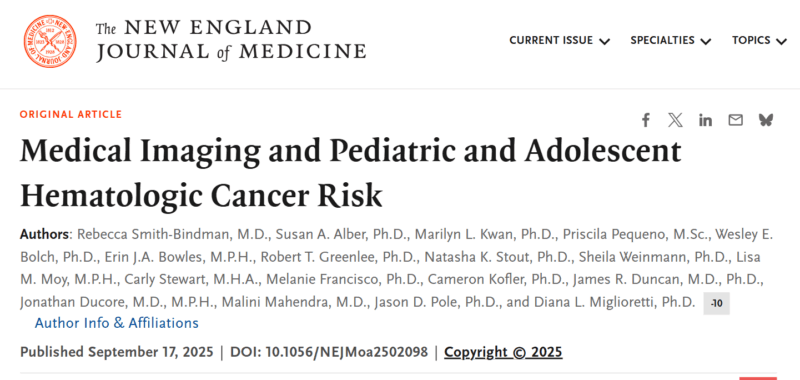Amol Akhade, Senior Consultant at Fortis Hospitals Mumbai, shared a post on LinkedIn about a paper by Rebecca Smith-Bindman et al. published in NEJM:
“NEJM 2025: Pediatric Imaging and Hematologic Cancer Risk – Signal, Noise, and Balance
A landmark study in NEJM (Smith-Bindman et al.) followed 3.7 million children across six U.S. health systems and Ontario, Canada, linking medical imaging radiation exposure to hematologic cancers.
Key Findings:
Clear dose–response relationship: risk of hematologic cancers rises with cumulative radiation dose to bone marrow.
- RR 1.41 at 1–5 mGy
- RR 1.97 at 30–50 mGy
- RR 3.59 at 50–100 mGy.
The Authors estimate ~10% of hematologic cancers may be attributable to imaging radiation.
Strongest signals for non-Hodgkin’s lymphoma, MDS, and histiocytic/dendritic tumors.
At first glance, this looks like a call to radically overhaul pediatric imaging. But the editorial perspective provides important context.
Editorial Nuance (Lindsay Morton, NCI):
- Absolute risks remain very low.
- Even at ≥30 mGy, the excess incidence was only 25.6 per 10,000 children.
- Most cancers (1261 of 2961) occurred in children with no imaging exposure.
- Associations at higher doses rely on small case numbers (only 31 cancers in the 30–50 mGy group).
- Residual biases (reverse causation, confounding by indication) remain possible despite lagged analyses.
- Imaging is not inherently ‘bad’ – CT and fluoroscopy are often lifesaving.
The Critical Balance: Yes, the signal is real.
- Even low-dose radiation exposure can increase hematologic cancer risk.
- But the absolute magnitude is tiny.
- For individual patients, the benefit of timely and accurate imaging often far outweighs this risk.
The real problem isn’t necessarily imaging, but overuse. Repeated CTs for minor trauma, duplicate scans, or ‘defensive medicine’ practices contribute to avoidable exposure. Solutions exist: Strict justification of pediatric imaging.
Dose minimization (‘as low as reasonably achievable’). Greater reliance on MRI/ultrasound when clinically feasible. Campaigns like Image Wisely and Image Gently to spread awareness.
My Take
This study provides the largest North American evidence quantifying pediatric imaging risk. But let’s not lose perspective:
It is a population-level warning, not a reason to deny a sick child a CT scan. The editorial wisely reframes the message: the risk is measurable, but very small. The lesson is not ‘avoid imaging,’ but avoid unnecessary imaging.
In the end, it is about balance: harnessing the diagnostic power of modern imaging while respecting the biologic cost of radiation, however small.
What changes (if any) should this evidence drive in your practice?
Would you be more conservative in ordering pediatric CTs – or are current safeguards already enough?”
Title: Medical Imaging and Pediatric and Adolescent Hematologic Cancer Risk
Authors: Rebecca Smith-Bindman, Susan A. Alber, Marilyn L. Kwan, Priscila Pequeno, Wesley E. Bolch, Erin J.A. Bowles, Robert T. Greenlee, Natasha K. Stout, Sheila Weinmann, Lisa M. Moy, Carly Stewart, Melanie Francisco, Cameron Kofler, James R. Duncan, Jonathan Ducore, Malini Mahendra, Jason D. Pole, Diana L. Miglioretti
You can read the Full Article in NEJM.

More posts featuring Amol Akhade.
